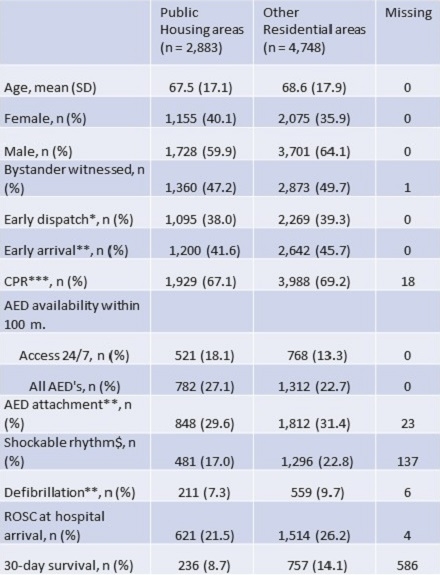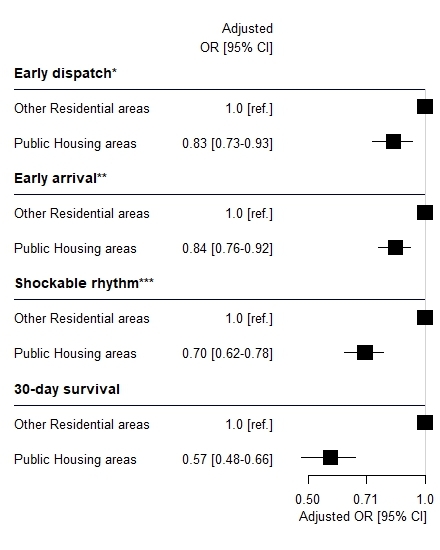Final ID: Or113
Response Times and Survival for Out-of-Hospital Cardiac Arrest Patients in Public Housing.
Abstract Body: Introduction
Public housing areas have a high incidence of out-of-hospital cardiac arrest (OHCA) and are potential targets to improve OHCA survival. A fast emergency medical services (EMS) response is crucial to achieve OHCA survival. However, EMS response times in public housing areas remain unexplored.
Research Question
Are EMS response times longer in public housing areas than in other residential areas?
Aim
The primary objective was to investigate EMS response times for OHCA in public housing compared to other residential areas; differences in initial shockable rhythm and 30-day survival were secondary objectives.
Method
Non-EMS witnessed OHCAs within residential areas from Amsterdam (2016-2021), Copenhagen (2016-2021), and Vienna (2018-2021) were included from the Amsterdam Resuscitation Studies and the Danish and Viennese Cardiac Arrest registries, excluding missing data on age, sex, and EMS response times. OHCAs were divided into public housing and other residential areas. Early dispatch was defined as <90 seconds from incoming call until dispatch of EMS vehicle; early arrival as < 6 minutes from dispatch of EMS vehicle until arrival on scene. We compared early dispatch, early arrival, initial shockable rhythm, and 30-day survival in public housing vs. other residential areas using a generalized estimation equation model adjusted for age, sex, and city and presented as adjusted odds ratios (aOR).
Results
We included 8,659 patients, of which 2,883 (33,3%) occurred in public housing areas. OHCA patients in public housing areas were younger, more often female, less likely bystander witnessed, and less often received bystander interventions compared to other residential areas (Table 1). Comparing OHCAs in public housing vs. other residential areas (reference), early dispatch was 38.0% vs. 39.3%, aOR 0.83 [95% CI 0.73-0.93]; early arrival, 41.6% vs. 45.7%, aOR 0.84 [95% CI 0.76-0.92]; initial shockable rhythm, 17.0% vs. 22.8%, aOR 0.70 [95% CI 0.62-0.78]; and 30-day survival, 8.7% vs. 14.1%, aOR 0.57 [95% CI 0.48-0.66] (Figure 1).
Conclusion
Dispatch and arrival of EMS vehicles took longer for OHCA patients in public housing compared to other residential areas, followed by a lower probability of initial shockable rhythm and 30-day survival. These findings suggest the EMS system as a relevant target for improving OHCA survival in public housing areas.
Public housing areas have a high incidence of out-of-hospital cardiac arrest (OHCA) and are potential targets to improve OHCA survival. A fast emergency medical services (EMS) response is crucial to achieve OHCA survival. However, EMS response times in public housing areas remain unexplored.
Research Question
Are EMS response times longer in public housing areas than in other residential areas?
Aim
The primary objective was to investigate EMS response times for OHCA in public housing compared to other residential areas; differences in initial shockable rhythm and 30-day survival were secondary objectives.
Method
Non-EMS witnessed OHCAs within residential areas from Amsterdam (2016-2021), Copenhagen (2016-2021), and Vienna (2018-2021) were included from the Amsterdam Resuscitation Studies and the Danish and Viennese Cardiac Arrest registries, excluding missing data on age, sex, and EMS response times. OHCAs were divided into public housing and other residential areas. Early dispatch was defined as <90 seconds from incoming call until dispatch of EMS vehicle; early arrival as < 6 minutes from dispatch of EMS vehicle until arrival on scene. We compared early dispatch, early arrival, initial shockable rhythm, and 30-day survival in public housing vs. other residential areas using a generalized estimation equation model adjusted for age, sex, and city and presented as adjusted odds ratios (aOR).
Results
We included 8,659 patients, of which 2,883 (33,3%) occurred in public housing areas. OHCA patients in public housing areas were younger, more often female, less likely bystander witnessed, and less often received bystander interventions compared to other residential areas (Table 1). Comparing OHCAs in public housing vs. other residential areas (reference), early dispatch was 38.0% vs. 39.3%, aOR 0.83 [95% CI 0.73-0.93]; early arrival, 41.6% vs. 45.7%, aOR 0.84 [95% CI 0.76-0.92]; initial shockable rhythm, 17.0% vs. 22.8%, aOR 0.70 [95% CI 0.62-0.78]; and 30-day survival, 8.7% vs. 14.1%, aOR 0.57 [95% CI 0.48-0.66] (Figure 1).
Conclusion
Dispatch and arrival of EMS vehicles took longer for OHCA patients in public housing compared to other residential areas, followed by a lower probability of initial shockable rhythm and 30-day survival. These findings suggest the EMS system as a relevant target for improving OHCA survival in public housing areas.
More abstracts on this topic:
A Comparison of Synchronized Versus Unsynchronized Mechanical Chest Compressions in a Swine Model
Marill Keith, Menegazzi James, Gumucio Jorge, Salcido David
Airway Opening Index is Associated with Return of Spontaneous Circulation in Swine and Humans with Cardiac ArrestBhandari Shiv, Coult Jason, Sharpe Zachary, Rea Thomas, Neumar Robert, Hsu Cindy, Counts Catherine, Sayre Michael, Johnson Nicholas


